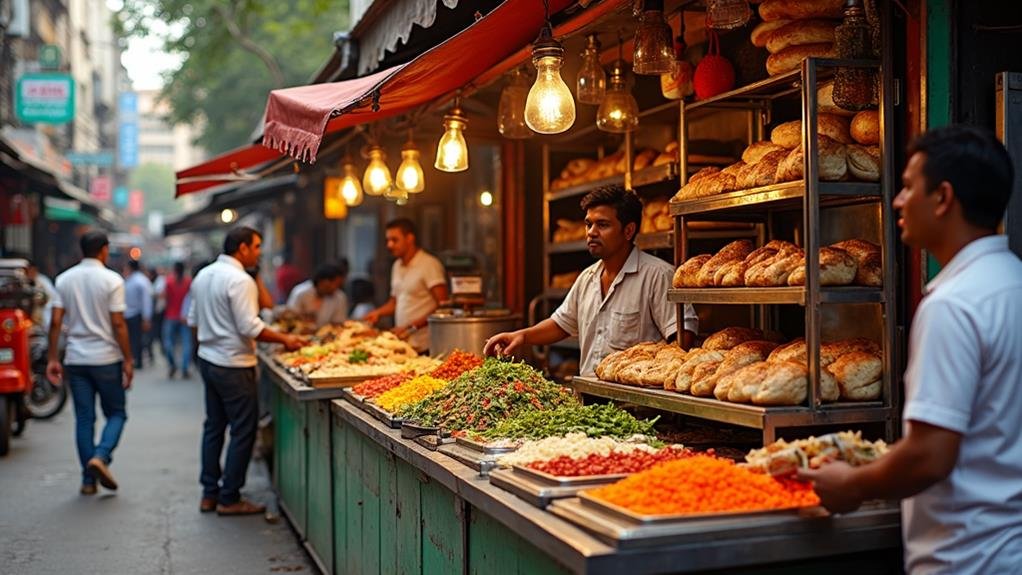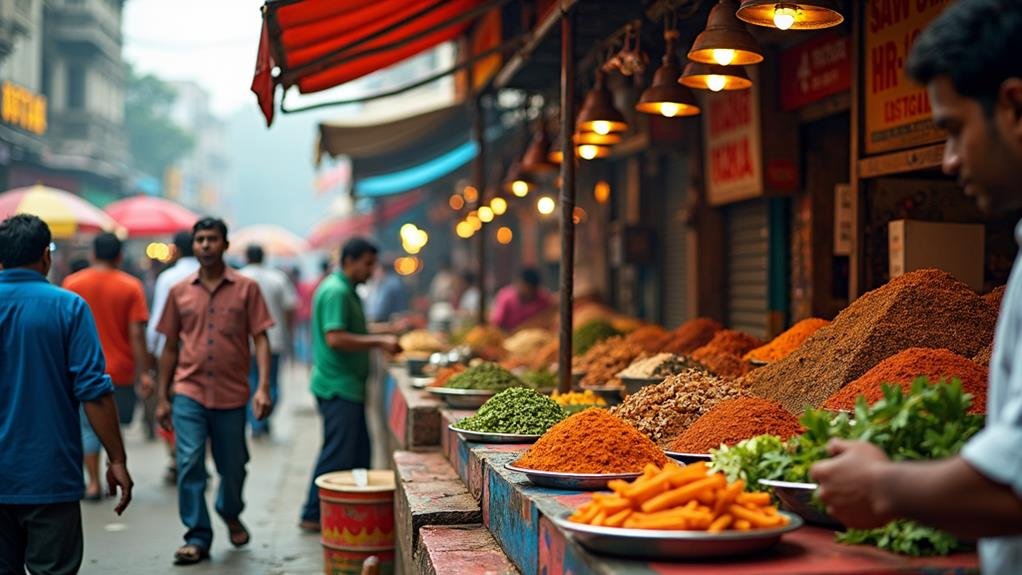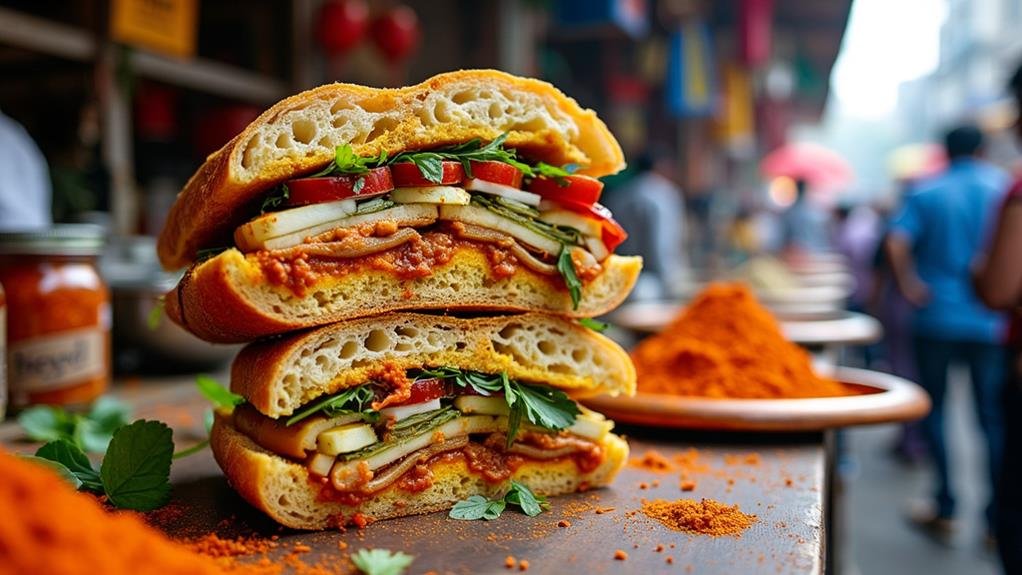The Bombay sandwich originated in the 1960s in Mumbai, symbolizing the city's diverse culinary landscape. Initially created to cater to the varied palates of newcomers, it integrates flavors from Indian, British, and Portuguese cuisines. Key ingredients typically include boiled potatoes, onions, and beetroot, complemented by a tangy green chutney. This dish quickly gained popularity among locals, students, and migrant workers due to its affordability and convenience. Over time, it has adapted to evolving tastes while maintaining its core elements. The Bombay sandwich continues to represent Mumbai's rich street food heritage and cultural significance, revealing further nuances of its storied past.
Origins and Ingredients
The Bombay sandwich, a dynamic representation of Mumbai's street food scene, originated in the 1960s to satisfy the diverse palates of newcomers to the city. This culinary creation embodies the rich fabric of Indian street cuisine, merging various culinary heritages into a single, convenient offering. Typically, it consists of toasted bread filled with a combination of ingredients, most commonly featuring boiled potatoes, onions, beetroot, and a tangy green chutney that delivers a flavorful punch.
The narrative of the Bombay sandwich mirrors the socio-economic environment of its era, emerging as an affordable and quick meal for the labor force, especially those working in textile factories. Its versatility allows for personalization, inviting additions like spicy chilies, cucumbers, and cheese, thereby catering to a broad demographic. This adaptability has inspired numerous variations, highlighting the ingenuity of street food vendors. The Bombay sandwich stands as a testament to the resilient nature of Indian street food, encapsulating the essence of a metropolis that thrives on diversity and culinary creativity.
Popularity and Appeal
Mumbai's lively street food scene features numerous choices, but the Bombay sandwich stands out, enchanting both residents and tourists. Its widespread appeal stems from several essential factors. First, the sandwich is remarkably convenient, making it a preferred option for hectic individuals seeking a swift meal. Second, it utilizes affordable and readily available components, ensuring accessibility for everyone. Lastly, the simple recipe allows for customization, catering to a wide array of tastes. Additionally, the use of soft white bread showcases the historical influences that shaped Mumbai's culinary landscape.
To fully appreciate the charm of the Bombay sandwich, consider these aspects:
- Convenience: Easy to carry and quick to assemble.
- Affordability: Crafted from inexpensive ingredients, accommodating various budgets.
- Customization: Can be enhanced with extras like cheese or spicy green chilies.
- Cultural resonance: Embodies a blend of influences, offering a unique culinary journey.
These elements contribute to the enduring popularity of the Bombay sandwich, transforming it into a beloved staple that symbolizes Mumbai's vibrant street food culture.
Local Identity and Evolution

Local culture and urban growth are essential to grasping the Bombay sandwich's significance. Emerging in the bustling streets of Mumbai during the 1960s, this iconic dish became a favorite among various groups, including locals, university students, and migrant workers. Its creation reflects the city's vibrant atmosphere, shaped by the very people who inhabited it, rather than being a product of culinary elitism.
The sandwich's name, rooted in the city's rich history, emphasizes its connection to regional identity. Food carts and stalls thrived in the 1970s, offering numerous variations that adapted to evolving tastes, showcasing the ingenuity of street food vendors. The local population embraced both hot and cold options, with grilled varieties cooked over charcoal, further embedding the sandwich into Mumbai's street cuisine culture.
As the metropolis evolved, the Bombay sandwich adapted, integrating an array of ingredients and flavors while maintaining its core elements. This evolution not only highlights the adaptability of regional dishes but also illustrates the resilience of a culinary creation that has become emblematic of Mumbai, showcasing how food can reflect a community's heritage and experiences.
Impact of Industry Decline
Economic changes in Mumbai, particularly the decline of the textile sector, have significantly shaped the city's food scene, including the lasting appeal of the Bombay sandwich. As textile factories encountered labor strikes in the 1980s and eventually shut down in the 2000s, numerous employees pursued alternative careers, leading to a shift in local gastronomy. Despite these financial hurdles, the Bombay sandwich has remained a cherished dish, showcasing notable resilience and versatility.
Key factors that contribute to the sandwich's enduring appeal include:
- Affordability: The components are inexpensive and easily accessible, making it a practical option for many residents.
- Personalization: Street vendors present various fillings, enabling customers to customize their sandwiches to suit their preferences.
- Culinary Evolution: The Bombay sandwich has adapted, integrating fresh ingredients while preserving its fundamental essence.
- Cultural Relevance: It symbolizes the city's heritage and the adaptability of its citizens, exemplifying culinary creativity in the face of economic adversity.
In this manner, the Bombay sandwich not only endures but flourishes, embodying the essence of Mumbai's vibrant food culture despite industrial challenges.
Cultural Significance and Global Love

The Bombay sandwich, a beloved street snack, is gaining global recognition. This culinary delight reflects Mumbai's rich food culture, blending Indian, British, and Portuguese tastes. It symbolizes local entrepreneurship and creativity, thriving despite the decline of the textile sector.
Internationally, the Bombay sandwich appeals to various communities, known for its refreshing flavor and convenience. It tells the story of Mumbai's diverse history, where different groups mingled and exchanged culinary practices. Its customizable nature makes it a versatile option for food enthusiasts around the world.
Street vendors in many countries now serve their interpretations of the Bombay sandwich, highlighting its rising popularity. This broad appeal emphasizes the sandwich's role as a cultural artifact, illustrating the interconnectedness of global cuisines. Ultimately, the Bombay sandwich is more than a meal; it is a treasured piece of culinary heritage, celebrated for its historical significance and ongoing relevance.


































